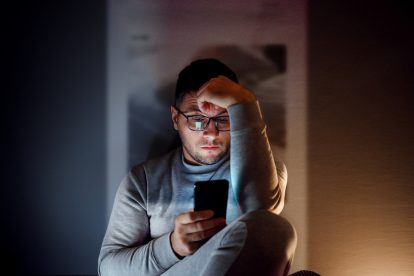
High-Functioning Social Anxiety
Social anxiety disorder is a mental health condition that impacts the lives of millions of Americans. After treatment and other efforts to get better many people with severe social anxiety improve dramatically, to the point where they can be classified as high-functioning. People who reach this stage—or who were always high-functioning—can form relationships, pursue careers, and make sustained efforts to fulfill their potential in all areas of life. Nevertheless, they continue to experience symptoms of anxiety that are unpleasant and life-altering, and that is why people with high-functioning social anxiety can still benefit from treatment.
Social anxiety disorder is the second most commonly diagnosed form of anxiety disorder. Sufferers experience overwhelming feelings of nervousness and fear of rejection during most social interactions, which leads them to avoid such situations if possible. People with full-blown social anxiety disorder can be severely limited by their social phobia, experiencing difficulties in many areas of their lives.
But chronic social anxiety is not always this disabling. Some people experience the fear and anxiety, but at a level that does not prevent them from forming relationships, holding down jobs, pursuing volunteer opportunities, making speeches, or otherwise performing or speaking in public. These individuals have high-functioning social anxiety, which is unpleasant and stressful but not paralyzing enough to keep sufferers from living a normal life.
Some people with high-functioning social anxiety have always been that way, while others experienced improvements in their anxiety symptoms and/or performance levels over time.
Symptoms of High Functioning Social Anxiety
Social anxiety produces physical, psychological, emotional, and behavioral symptoms. For those with normal social anxiety disorder, all their symptoms reinforce their inability to socialize and communicate.
People with high-functioning social anxiety do experience the same physical and psychological/emotional symptoms as other social anxiety sufferers, but usually at reduced levels of intensity. And they exhibit far fewer behavioral symptoms, which is the primary reason their social anxiety carries the label high-functioning.
The physical symptoms of social anxiety include:
- Blushing
- Sweating
- Rapid heartbeat
- Lightheadedness, dizziness
- Stomach cramps or nausea
- Difficulty breathing
- Trembling
- Dry mouth
- Difficulty thinking of the right words when speaking
People with high-functioning social anxiety are familiar with each of these symptoms, although they don’t manifest as frequently or as strongly as they do in people with more serious social phobia. Nevertheless, such symptoms can be exhausting and unpleasant, and high-functioning social anxiety sufferers don’t look forward to social encounters that are likely to provoke such reactions.
Meanwhile, the psychological and emotional symptoms of social anxiety can be experienced before, during, and after social encounters. They include:
- An intense fear of rejection
- Constant fear of saying or doing something embarrassing
- Extreme discomfort around authority figures
- Reluctance to express viewpoints openly and honestly
- Obsession over worst-case scenarios and negative outcomes
- Defensiveness and paranoia when asked questions
- Fear that anxiety reactions are visible and will be noticed by others
- Assuming that others are hostile and quick to judge
- Shame over the social anxiety, or about being “different”
- Intense self-criticism and second-guessing after social encounters have ended
People with social anxiety disorder suffer from excessive and disabling self-consciousness, which can make even previously desired social interactions hard to endure. Those with high-functioning social anxiety experience many of the same thoughts and fears, but they have developed strategies to push through the fear and engage with others when necessary.
Social anxiety disorder impacts behavior as well as emotions, as sufferers often go to extreme lengths to avoid unnecessary social encounters. When interactions are unavoidable they will speak as little as possible and escape as quickly as they can, despite the shame their avoidant behavior makes them feel. They tend to prefer online interactions over using the phone or speaking to people in person, and they develop the habit of doing things alone that others do with companions.
People with high-functioning social anxiety may also avoid human contact if they judge it as non-essential. But for the most part they don’t let their social fears prevent them from doing what they really want to do. Because their avoidant behavior is more restrained and controllable they can make friends, find romantic partners, apply for jobs, ask for help in stores, or do a thousand other things those with severe social anxiety find problematic.
The amount of human contact they initiate is still somewhat limited in comparison to more outgoing people, and they still tend to be uncomfortable around strangers or casual acquaintances. But people with high-functioning social anxiety are not so quick to let opportunities for satisfying experiences pass them by, and their lives are richer and more rewarding than those of social anxiety disorder sufferers as a result.
Call for a Free Confidential Assessment.
877-727-4343From Severe Social Anxiety to High-Functioning: Making the Transition
The symptoms of some with high-functioning social anxiety were always mild or moderate. What they’ve experienced is more stressful and life-altering than normal shyness, but their social anxiety was never powerful or intimidating enough to seriously hamper their ability to build relationships or achieve their goals.
However, the situation for many high-functioning social anxiety sufferers is different. In childhood, during adolescence and into young adulthood, their social anxiety symptoms were strong and persistent, limiting their activities in many ways and inhibiting them in their search for happiness and fulfillment. Only over time were they able to get a handle on their social anxiety, learning to cope with it well enough to finally break out of their self-imposed social exile.
There are a number of reasons why some people overcome the worst of their social anxiety symptoms. Most men and women who recover from social anxiety disorder do so only after seeking treatment, often at a residential mental health treatment facility. With a combination of psychotherapy and medication, most social anxiety sufferers can eventually learn to manage their symptoms, which may decline in intensity if treatment continues for an extended period.
While treatment for social anxiety disorder is vitally important, there are often other factors involved that help sufferers make the transition from severe to high-functioning social anxiety. Some of these factors include:
Self-help
In addition to or in place of treatment, many social anxiety sufferers will turn to self-help books that describe techniques or strategies for overcoming their nervousness around people. They may also sign up for courses that promise to teach communication skills or methods for overcoming shyness or self-esteem problems. Online forums and social media offer still more options for self-help, for socially anxious people looking to connect with peers for advice and moral support.
While books, classes, and online friends cannot replace organized treatment, as a supplement to it they can be quite impactful.
Mind-body healing techniques
Holistic wellness practices have grown in popularity in recent years, as word about the health-enhancing effects of yoga, meditation, massage therapy, Tai Chi, music and art therapy, hypnosis, biofeedback, and other mind-body healing techniques has spread. Many residential mental health treatment centers now offer holistic healing practices as a part of their recovery programs, which is a testament to how well they work both inside and outside of rehab.
For social anxiety sufferers, and those who experience anxiety in general, holistic mind-body practices can help relieve stress and assist in the ongoing process of retraining the brain to react with less fear and paranoia during social interactions.
Declines in intensity related to aging
One long-term study of social anxiety disorder sufferers found that 37 percent showed significant improvement in their symptoms over a 12-year period, despite not receiving any treatment.
However, the average survey participant had already experienced social anxiety for 19 years at the beginning of the experiment, so these statistics don’t suggest much hope of spontaneous improvement for younger social anxiety sufferers. Also, the 37-percent improvement rate was markedly lower than the recovery rates for generalized anxiety disorder (58 percent) and panic disorder (82 percent). So age-related improvements aside, treatment remains critically important for most people suffering the symptoms of severe social anxiety.
The need to take care of life’s necessities
Regardless of the severity of their initial social phobia symptoms, most social anxiety sufferers still must fulfill certain life responsibilities in order to survive. This could mean enrolling in college, meeting all academic requirements on chosen career tracts, interviewing for jobs, and performing all workplace duties and assignments necessary to do a job correctly once it has been secured. Interpersonal imperatives also cause many social anxiety disorders sufferers to reach out to others for love or friendship, and that is now easier to do through various online venues.
The strength of their social anxiety symptoms notwithstanding, most social anxiety disorder sufferers will eventually reach out to, connect with, or be forced to interact with other people, and as they gain more experience interacting with others their social skills and comfort level are bound to improve to a degree.
Treatment for Social Anxiety Disorder and High Functioning Social Anxiety
People with high-functioning social anxiety are relatively privileged in comparison to those with social anxiety disorder. But they often earned their high-functioning status through hard work, dedicated effort, and an ongoing commitment to treatment, which is an avenue for recovery potentially open to all.
As a starting point, inpatient social anxiety treatment programs in a residential mental health facility gives social anxiety disorder sufferers the best chance for eventual recovery. But inpatient treatment also has much to recommend it for those who’ve been high-functioning for many years, who often suffer in silence despite outward appearances.
With intensive, round-the-clock treatment services in a fully supportive healing environment, men and women with high-functioning social anxiety can find further relief from their most persistent symptoms, which may remain unpleasant, stress-inducing, and limiting in many ways despite not being fully debilitating.
While there is no cure for social anxiety, when its symptoms are present there is always room for improvement, even if those symptoms haven’t been a substantial barrier to achievement. Mild-to-moderate social anxiety is still social anxiety, and inpatient and outpatient treatment programs are still appropriate and usually highly effective for those who experience social anxiety in any form or at any level of intensity.





